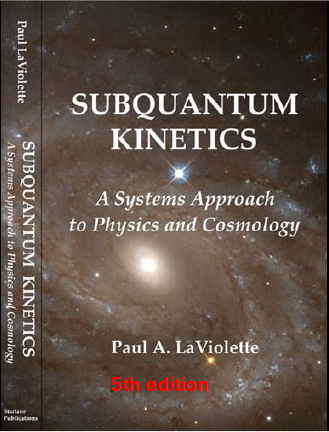
Subquantum Kinetics: A Systems Approach to Physics and Cosmology
A novel systems approach to physics that has far reaching implications for field theory, astronomy, and cosmology.
Reviews of Subquantum Kinetics: https://etheric.com/LaVioletteBooks/SQK-review.html
Subquantum Kinetics predictions and their verification
Price for the Fifth edition in pdf format is $35. If you prefer instead to order the older Fourth edition which is only available in ebook format you should go to the book portal below this one.
Also please note that the 3rd edition paperback is currently out of print.
New Features Found in the Fifth Edition of Subquantum Kinetics
Compared to the fourth edition of Subquantum Kinetics, this fifth edition contains 38 pages of additional material, 7% more, including 11 new photos and diagrams. Active links throughout the book link to downloadable papers and movie simulations.
In Chapter 4 The Emergence of Particles and Fields:
Material in Ch. 4 of the 4th edition discussing computer simulations performed by M. Pulver on the Model G reaction system has been transferred to a new chapter, Ch. 12, added at the end of the book in the 5th edition. Review of reaction-diffusion simulation work performed by other researchers has also been moved to this new chapter.
In Chapter 5 Fields and Forces:
A new subsection entitled “nonEinsteinian relativistic effects” has been added to the end of Ch. 5. This includes discussion of a method of slowing down the flow of time in the laboratory by artificially creating a local ether wind. Includes discussion of how this is accomplished and how the effect is predicted by subquantum kinetics (SQK). In this same section, this is followed by a discussion of how a gravity potential hill induced by a negative virtual charge should be able to induce a state of matter invisibility and partial dematerialization of Turing wave patterns in material bodies, thereby creating an effect similar to that produced in the Philadelphia Experiment.
In Chapter 6 Energy Wave Behavior:
A subsection has been added entitled “Teleportation via Quantum Entanglement”. This speculates on a method of inducing matter teleportation between two locations that have previously been induced into a state of quantum entanglement, and subsequently subjecting the send location to a matter-dematerializing gravity potential hill. This is explained in the context of SQK.
In Chapter 7 The Cosmological Redshift:
• The expanding universe cosmology and static universe tired-light cosmology are tested against a few additional cosmological data sets making the overall test results even more conclusive and vindicating the tired-light prediction of SQK.
• The value of the Hubble constant is also updated based on new redshift-time-of-flight data.
• The SQK explanation for the quantized redshift effect is discussed more extensively.
In Chapter 8 Matter Creation:
Improvements have been made throughout the chapter, including an additional example of a mother galaxy spawning a daughter a galaxy.
In Chapter 9 Genic Energy:
The new conclusion that neutron stars do not exist as conventional astronomy claims. That this concept is a misinterpretation of energetic bare stellar cores.
In Chapter 11 Electrogravitics (two new sections):
• A section has been added which describes a novel way of electrogravitically propelling a spacecraft by creating a positive virtual gravitational potential outside the spacecraft hull using the field-induced-soliton phenomenon technique. The craft termed the Aquarian Monopolar Elevator is shown to be able to execute extreme accelerations without inertial reaction effects by manipulating the rate of field pulsing to various hull sectors.
• A section is added which discusses the Navy’s Paias patent on a method of propelling a spacecraft using electrogravitic microwave oscillations. Serious flaws in the patents are pointed out, and the operation of the patented spacecraft is shown to be more readily understood when understood as a variation of the Aquarian Monopolar Elevator design.
In Chapter 12 Computer Simulations of Model G:
A new chapter has been added describing computer simulation work carried out on SQK Model G partial differential equation system. This includes 1D simulations previously published in Chap. 4 of the Fourth Edition, carried out by M. Pulver. It also includes 2D simulations carried out by B. Darrer and the Model G Vortical Motion Group. This includes evidence that a Model G dissipative soliton will accelerate when subjected to the influence of a gravity potential gradient.
In Chapter 13 Conclusion:
This chapter now includes a subsection that explores metaphysical questions raised by the subquantum kinetics approach. Such matters include the nature of the divine, observational evidence for the occurrence of spontaneous materialization, and discussions of paranormal phenomena such as psychokinesis, telepathy, and remote viewing.